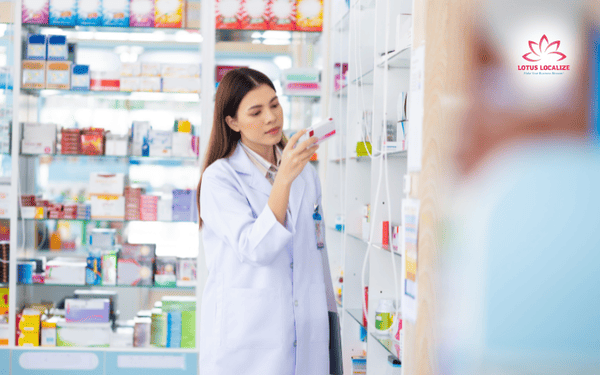
Roadblocks and strategies in biomedical translation for healthcare and pharmaceutical industries
In today’s interconnected world, the role of biomedical translation has become increasingly vital. This specialized field ensures that medical innovations, research breakthroughs, and healthcare communications transcend language barriers, reaching audiences across the globe. From medical research publications to patient instructions, this field enables critical information to flow seamlessly between countries and languages, fostering innovation and collaboration on a global scale. This post highlights the essential role of biomedical translation in global healthcare, bridging language gaps to bring medical innovations to diverse populations and support safe, worldwide collaboration.
Unlocking the world of biomedical translation
Biomedical translation serves as a bridge between medical breakthroughs and their real-world applications. It is the lifeline that connects healthcare innovations with diverse audiences, ensuring that patients, doctors, researchers, and pharmaceutical companies can all communicate effectively.

This field encompasses a broad spectrum of activities, from translating clinical trial reports to localizing medical devices and pharmaceutical labels, making it essential for advancing global health initiatives. The success of these translations often determines the accessibility and adoption of medical advancements, directly impacting public health outcomes.
Biomedical translation also plays a crucial role in emergency response scenarios. During public health crises, such as pandemics, the rapid and accurate translation of medical advisories, research findings, and treatment protocols can save countless lives. This highlights the indispensable nature of high-quality biomedical translation in safeguarding global health.
Read more: Accurate medical device translation: the cornerstone of compliance and global success
Diverse applications of biomedical document translation
The applications of biomedical translation extend far beyond these core areas, influencing various aspects of the healthcare and life sciences industries:
- Pharmaceutical industry: Translating drug development documents, such as regulatory submissions, clinical trial protocols, and patient information leaflets, is crucial. Consistency and accuracy in these translations ensure approval from regulatory authorities and safeguard patient safety. Misinterpretations in drug labeling or clinical instructions could have serious consequences, emphasizing the need for high-level expertise.

- Healthcare communication: Localizing medical records, patient consent forms, and hospital policies ensures clarity and compliance across languages. Effective translation fosters trust between healthcare providers and patients, improving the overall quality of care. This is especially important in multicultural societies or regions with diverse populations, where clear communication can prevent medical errors and enhance patient outcomes.
- Research and academia: Translating research papers, case studies, and conference materials allows for the global sharing of knowledge, fostering collaboration among scientists and researchers worldwide. Translating scientific literature can accelerate the pace of medical advancements, contribute to the fight against diseases, and open new avenues for cross-border partnerships in research and development.
- Medical device industry: Translating user manuals, instructions for use (IFUs), and safety guidelines for medical devices ensures that devices are used correctly and safely by healthcare providers and patients in different regions. Accurate translation in this area is critical for maintaining safety standards and regulatory compliance, particularly for international market access.

- Public health and policy: Biomedical translation plays a significant role in disseminating public health information and policies to diverse populations. This includes translating health advisories, vaccination information, disease prevention guidelines, and emergency responses. Ensuring that these messages are correctly conveyed in various languages is essential to reaching at-risk populations and improving health outcomes on a global scale.
- Patient education materials: Translating brochures, websites, and videos that educate patients about diseases, treatment options, and preventative care in different languages ensures that people understand their health conditions and available options. This promotes informed decision-making and empowers patients to take charge of their healthcare journey.
- Regulatory compliance and legal documentation: Translating contracts, licensing agreements, and patent applications for the pharmaceutical and biotech industries is essential for ensuring compliance with international laws and securing intellectual property rights. Mistakes in these translations could lead to legal disputes or loss of valuable patents.
Each of these areas requires a delicate balance of linguistic proficiency, scientific accuracy, and cultural awareness. Biomedical translators must continually update their knowledge of medical terminology, industry regulations, and local cultural nuances to meet the evolving demands of this highly specialized field. By providing high-quality translations, they contribute to the well-being of individuals and the progress of global healthcare and research.
Obstacles in achieving accurate biomedical translations
Achieving accurate biomedical document translations comes with several hurdles that require specialized knowledge and careful attention to detail:
Complex terminology
Biomedical terminology is often highly technical and varies from one language to another. Translators must have a deep understanding of both medical concepts and language to ensure accurate translation. Sometimes, a term in one language may not have a direct equivalent, necessitating the use of creative and precise alternatives.
Solution: Translators should collaborate with subject matter experts and keep abreast of the latest medical terminology updates to ensure accuracy and consistency across languages.

Divergent regulatory standards
Different regions have specific regulatory guidelines, such as FDA standards in the U.S. or EMA requirements in Europe. These regulations must be considered during translation to ensure compliance with local laws and medical practices.
Solution: A clear understanding of regional regulations is crucial, so partnering with legal and regulatory experts can help ensure that translations align with the necessary standards.
Cultural sensitivity
Cultural nuances can significantly impact the effectiveness and appropriateness of medical translation. Certain phrases or medical concepts may carry different meanings or connotations in different cultures, leading to potential misunderstandings or mistrust.
Solution: Translators should work with professionals who are not only bilingual but also culturally aware. They can adapt the content to ensure it resonates with the local audience without compromising the original meaning.

Technical accuracy
Biomedical texts often contain intricate details related to drugs, treatment protocols, and research findings. Even slight inaccuracies can lead to misinterpretation and compromise patient safety.
Solution: Utilizing specialized translation software and tools can help maintain technical accuracy, while cross-checking with scientific experts ensures reliability.
Multilingual coordination
In some cases, biomedical translations require coordinating content across multiple languages simultaneously. Managing consistency while ensuring the accuracy of each language version can become challenging.
Solution: Implementing a robust quality control system with multiple rounds of review from bilingual experts and using translation memory tools can help maintain consistency and quality across languages.
These obstacles require translators to have more than just linguistic expertise—they need in-depth knowledge of the biomedical field, cultural awareness, and a strong understanding of local regulations. By addressing these challenges through collaboration and continuous learning, translators can deliver high-quality, accurate biomedical translations.
Read more: Clinical trial translation: Key to success in global healthcare research
Skills and knowledge required for biomedical translators
Biomedical translators require a multifaceted skill set to navigate the complexities of this specialized field:
- Deep domain knowledge: Translators must be well-versed in medical, pharmaceutical, and technical concepts. This knowledge allows them to understand and accurately translate complex scientific data, medical procedures, clinical trial protocols, drug terminology, and medical device specifications. They must also be familiar with regulatory standards and clinical guidelines relevant to specific regions.
- Attention to detail: Precision is paramount in biomedical translation. A small error, such as a mistranslation of dosage instructions or medical terminology, could lead to serious consequences, including harm to patients or compromised treatment protocols. Translators must adopt a meticulous, error-free approach to ensure the safety and effectiveness of medical information.

- Cultural competence: Translators must have a keen understanding of regional linguistic nuances and cultural sensitivities. Different regions may have unique preferences for units of measurement, date formats, or even certain medical terms. Ensuring that translations are culturally appropriate and locally relevant improves clarity, trust, and patient comprehension. This is particularly critical when translating patient-facing documents, such as informed consent forms and educational materials.
- Scientific and regulatory knowledge: In addition to language proficiency, biomedical translators must keep up with the latest advancements in medical science and evolving regulatory requirements. Knowledge of international standards such as Good Clinical Practice (GCP) or the FDA’s drug approval processes helps ensure that translations meet legal and industry specifications.
- Advanced technological skills: Proficiency with translation memory (TM) software, terminology management tools, and machine-assisted translation (MAT) systems is essential for maintaining consistency and efficiency. These tools help store and reuse previous translations, ensuring that the same terms and phrases are translated consistently across projects. Additionally, they reduce the time needed to complete large-scale projects and enhance overall productivity.

- Ethical and confidentiality standards: Biomedical translators must adhere to strict ethical guidelines to protect sensitive patient data and confidential medical information. Maintaining confidentiality and following data protection laws such as HIPAA in the U.S. is critical to safeguarding patient privacy and ensuring legal compliance.
- Communication and collaboration skills: Effective communication with clients, medical professionals, and subject matter experts is essential. Translators may need to seek clarification on technical or ambiguous terms, collaborate on terminology choices, or explain complex translation decisions. Good collaboration ensures that translations are as accurate and effective as possible.
- Continuous learning and certification: Due to the fast-paced nature of medical and pharmaceutical advancements, biomedical translators must engage in ongoing learning. Professional certifications, such as those offered by the American Translators Association (ATA) or the Institute of Translation and Interpreting (ITI), help translators maintain credibility and demonstrate their expertise in this highly specialized field.
By mastering these skills, biomedical translators contribute to the delivery of accurate, reliable, and culturally appropriate medical content that impacts patient safety, healthcare quality, and scientific progress on a global scale.
Adhering to global standards in biomedical translation
Compliance with established standards and regulations is critical:
- ISO certifications: Following ISO 17100 standards ensures consistent quality management. These standards provide a framework for maintaining accuracy and reliability throughout the translation process.

- Regulatory alignment: Adapting translations to meet the requirements of regulatory bodies like the FDA, EMA, or CFDA. Translators must also understand specific local guidelines, such as those for medical device labeling or pharmacovigilance.
- Data security: Safeguarding patient confidentiality and sensitive information by adhering to HIPAA and GDPR guidelines. Robust data encryption and secure workflows are essential to protect client information.
By aligning with these standards, translation providers build trust and demonstrate their commitment to excellence. This not only ensures compliance but also enhances the reputation of medical institutions and pharmaceutical companies that rely on these services.
Why Lotus Localize stands out in biomedical translation?
At Lotus Localize, we bring a unique approach to biomedical translation:
- Industry expertise: Our team of translators combines linguistic proficiency with a deep understanding of the medical and pharmaceutical fields. With specialized training and years of experience, our professionals deliver translations you can trust.

- Customized solutions: We tailor our services to meet the specific needs of healthcare providers, researchers, and pharmaceutical companies. Our flexible approach ensures that each project is handled with the care and precision it deserves.
- Commitment to trust: We prioritize accuracy, confidentiality, and compliance with global standards to deliver translations that our clients can rely on. Every step of our workflow is designed to meet the highest industry benchmarks.
Whether you need patient materials localized or technical documents translated, our solutions are designed to support your mission of improving global health outcomes. From start to finish, Lotus Localize offers a seamless, client-centered experience that ensures your translations meet both linguistic and technical excellence.
Biomedical translation is a cornerstone of modern healthcare, enabling the seamless exchange of medical knowledge and technology across linguistic barriers. With its far-reaching applications and unique challenges, this field demands a professional touch that combines expertise and precision. Lotus Localize is dedicated to providing trusted, high-quality biomedical translation services, ensuring that your message resonates effectively and accurately worldwide. Contact us today to elevate your translation needs to a new standard of excellence.
Lotus Localize offers professional translation services for various specialized industries: life science translation, IT translation, manufacturing translation, e-learning translation, legal translation,… ensuring your message resonates—whether in writing or speech. Let us help you bridge linguistic gaps and connect with audiences worldwide.
Contact us today at our hotline or Whatsapp: + 84 866 224 968 or visit the websites: dichthuathoasen.com/en/. Let Lotus Localize accompany you in bringing products, people, and culture to the global stage, and together, we’ll create miracles!
QUALITY PROMISE
At Lotus Localize, we are dedicated to delivering high-quality services and ensuring the utmost satisfaction in every client project. Our team of translators and staff consistently exert effort and adhere rigorously to quality management procedures. This commitment guarantees that each project progresses seamlessly, meets deadlines, and exceeds our clients' expectations.












